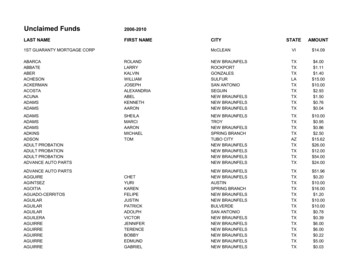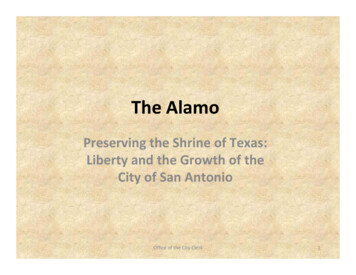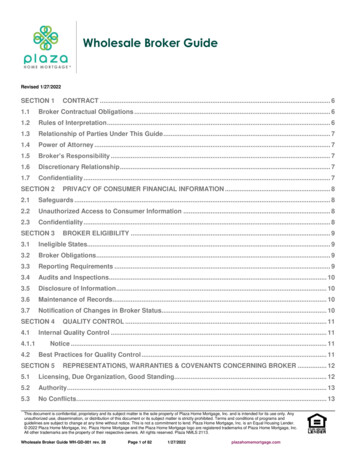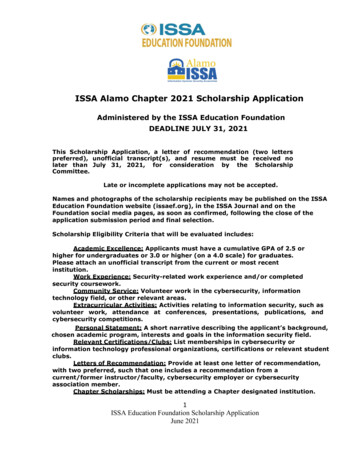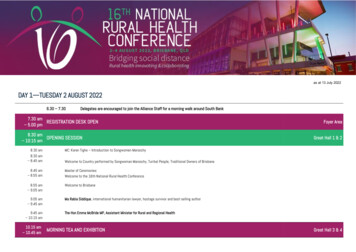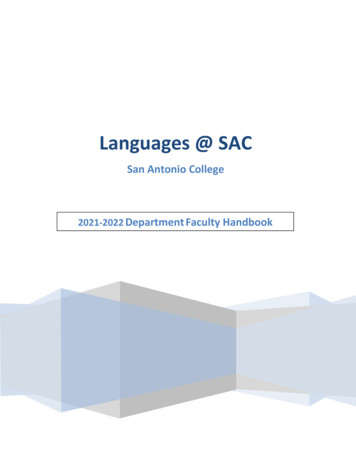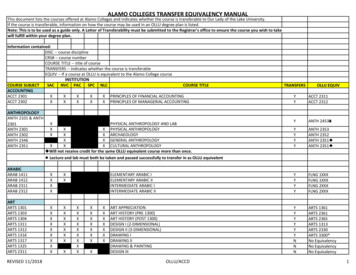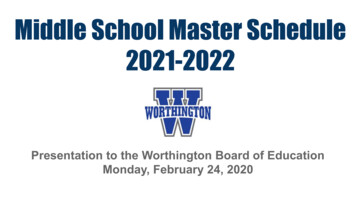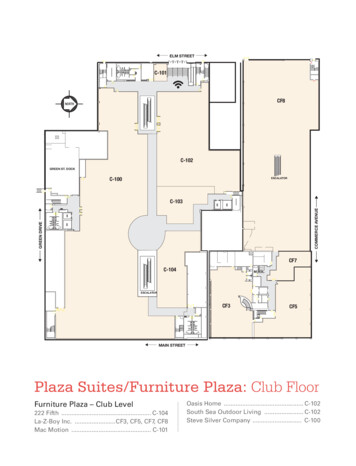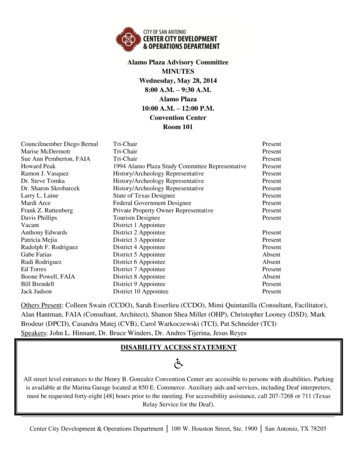
Transcription
Alamo Plaza Advisory CommitteeMINUTESWednesday, May 28, 20148:00 A.M. – 9:30 A.M.Alamo Plaza10:00 A.M. – 12:00 P.M.Convention CenterRoom 101Councilmember Diego BernalMarise McDermottSue Ann Pemberton, FAIAHoward PeakRamon J. VasquezDr. Steve TomkaDr. Sharon SkrobarcekLarry L. LaineMardi ArceFrank Z. RuttenbergDavis PhillipsVacantAnthony EdwardsPatricia MejiaRudolph F. RodriguezGabe FariasRudi RodriguezEd TorresBoone Powell, FAIABill BrendellJack JudsonTri-ChairTri-ChairTri-Chair1994 Alamo Plaza Study Committee RepresentativeHistory/Archeology RepresentativeHistory/Archeology RepresentativeHistory/Archeology RepresentativeState of Texas DesigneeFederal Government DesigneePrivate Property Owner RepresentativeTourism DesigneeDistrict 1 AppointeeDistrict 2 AppointeeDistrict 3 AppointeeDistrict 4 AppointeeDistrict 5 AppointeeDistrict 6 AppointeeDistrict 7 AppointeeDistrict 8 AppointeeDistrict 9 AppointeeDistrict 10 rs Present: Colleen Swain (CCDO), Sarah Esserlieu (CCDO), Mimi Quintanilla (Consultant, Facilitator),Alan Hantman, FAIA (Consultant, Architect), Shanon Shea Miller (OHP), Christopher Looney (DSD), MarkBrodeur (DPCD), Casandra Matej (CVB), Carol Warkoczewski (TCI), Pat Schneider (TCI)Speakers: John L. Hinnant, Dr. Bruce Winders, Dr. Andres Tijerina, Jesus ReyesDISABILITY ACCESS STATEMENTAll street level entrances to the Henry B. Gonzalez Convention Center are accessible to persons with disabilities. Parkingis available at the Marina Garage located at 850 E. Commerce. Auxiliary aids and services, including Deaf interpreters,must be requested forty-eight [48] hours prior to the meeting. For accessibility assistance, call 207-7268 or 711 (TexasRelay Service for the Deaf).Center City Development & Operations Department 100 W. Houston Street, Ste. 1900 San Antonio, TX 78205
1. Welcome by Committee Tri-Chairs2. Alamo Plaza Walking Tour led by John L. Hinnant. Historical and Archeological (support by Dr.Andres Tijerina, Dr. Bruce Winders, and Dr. Steve Tomka): The tour started with Dr. Windersdiscussing the plaza and its relationship to the chapel. Mr. Hinnant began the tour in front of the chapeland demonstrated where the walls of the Alamo compound were during the 1836 Battle of the Alamo.3. Introduction of national consultant, Alan Hantman, FAIA4. Presentations on Historical Contexta. Dr. Andres Tijerina, Professor of History, Austin Community College, Fellow, Texas StateHistorical Association. Presented an inclusive summary of Mission de Valero including formerlocations to current location of the mission. Presented information regarding the evolution of thesite from indigenous populations through colonization, European settlers, Mexican influence,Tejanos, through the Battle of the Alamo in 1836. Emphasis that Tejanos and Latinos fought onboth sides of the battle and should be recognized as such. There shouldn’t be the victors and thelosers, but a balanced approach showing virtues of both sides. All Texans should be proud of thesite and the battle. The community in and around Mission San Antonio de Valero reflectschange over time, and the area of the Alamo reflects changes in the community. There should bemore artifacts to go with the entire story of the site over time, not just emphasis on the battle.(Presentation based a chapter Dr. Tijerina wrote in Lone Star Pasts: Memory and History inTexas, Edited by Gregg Cantrell and Elizabeth Hayes Turner (College Station: Texas A&MUniversity Press, 2007), Chapter 7: “Constructing Tejano Memory,”).b. Dr. Bruce Winders, Historian and Curator, the Alamo: Presentation emphasizing that the visitorinformation should reflect why the community in and around the mission formed and developedthe way it did, the events that transpired leading to the 1836 Battle of the Alamo, and how theCity of San Antonio developed around the Alamo the way it did. The history of the U.S. can’t betold without Texas, and the history of Texas can’t be told without the Tejanos and the Battle ofMedina in 1813. The Alamo has been transformed from a place into a concept, an image, asymbol. We need to try to give tourists a continuum, before and after 1836. It is a rareoccurrence to see a San Antonian at the Alamo – only school children and out-of-towners. Noresidents. The Alamo is not just a place, it was a community. There are two story lines- thetraditional story and the evidence-based story. We need to concentrate on people, not just action.c. Larry Laine, Chief Clerk and Deputy Land Commissioner, Texas General Land Office (GLO):Overview of improvements made to the Alamo grounds, chapel, and long barracks since it hascome into possession of the GLO. Improvements include additional funding, increase in percapita spending, additional special temporary exhibits, website improvements, preservation,shrine roof improvements, long barrack roof replacement, arbor extension, HVAC installation,LED lighting, windows and doors restoration, and IT improvements. GLO would like to see thedevelopment of a visitor center to introduce new educational opportunities and ongoingCenter City Development & Operations Department 100 W. Houston Street, Ste. 1900 San Antonio, TX 78205
archeological digs. GLO wants to improve signage and amenities such as restrooms, foodservice, vending, and rest area options. SPEAKING POINTS ATTACHED.d. Jesus Reyes, Representative, American Indians of Texas: Overview of Coahuiltecan history,importance of the lands to the Native American tribes whose ancestors are buried on the groundsof the Alamo. Presentation about the native “unsung heroes” of San Antonio de Valero whofought off attacking Apache Kiowas, saving the families and soldiers of the mission. Also, themissions were built by native labor. SPEAKING POINTS ATTACHED.5. Wrap-up, meeting adjourned.Center City Development & Operations Department 100 W. Houston Street, Ste. 1900 San Antonio, TX 78205
ATTACHMENT 1Speaking Points from Presentation by LarryLaine
Talking Points for Alamo Plaza Advisory GroupThe General Land Office believes that Alamo Plaza is vital to accurately portraying the story of theAlamo and that these properties should be under the same authority. The GLO would like to seeupgrades made to the Plaza though physical improvements and increased education in order tobetter tell the story of the site.The GLO seeks to improve the visitor experience and would like to see the development of a visitorcenter, which would provide museum space and relieve the pressure on the Shrine and LongBarracks as the only display space. A visitor center would provide the opportunity to introduce neweducational opportunities, and improve amenities such as restrooms, food service, vending, and restarea options, which are all currently lacking in size and quality.The GLO would like to see more exhibits and signage throughout the complex and Plaza to improvea visitors understanding of the site. The GLO is considering moving the administration offices off siteto make room for improvements within the Alamo complex and would like to remodel the AlamoResearch Center.The GLO has had responsibility for the Alamo for less than 3 years. The GLO has made greatimprovements at the Alamo and has proved capable of acquiring the resources for care andmaintenance. Some of the improvements are listed below.Improvements Professional ManagementThe GLO has brought a new level of professionalism to the management of the Alamo, includingthe adoption of the first Alamo Management Plan, new accounting and auditing practices,insurance, and inventories.Financial HealthThe GLO is focused on the financial health of the Alamo, which is now operating in the black andthe revenues are sufficient to pay for the operation of the site. Additionally, the GLO requestedand received an additional 1.125 million from the Legislature for upgrades to the Alamo. Lastly,Event Network, which the GLO hired to run the Gift Shop, has increased the per capita spendingby 51%.Alamo EndowmentIn the fall of 2013, a private non-profit, The Alamo Endowment, was created at the direction ofthe GLO to assist with large-scale fundraising. The 501(c)(3) approval was recently granted bythe IRS and we are eager to launch a fundraising campaign for the Fall. There are plans for agala on October 30th to kick off large scale fundraising.Special temporary exhibits
The GLO has organized 3 temporary special exhibits in the Alamo Shrine, including bringing theTravis letter back to the Alamo for the first time. We are implementing a plan to have at leastone new exhibit per year to encourage repeat guests.Web site improvementsA new web site was unveiled last year for The Alamo. Navigation was improved and newfeatures were added to assist the visitor (for example, accepting donations and membershipsonline). The site is under continuous review for additional improvements.Preservation:Five contracts were awarded in the Fall of 2012. Trinity University, Texas A&M University, FineArts Conservation, Building and Monument Conservation and Sparks Engineering were allcontracted to perform various studies, including structural studies of stone conditions;paint/graffiti exploration; temperature and humidity studies; and, photographing. Several ofthe projects are complete with additional work continuing on the Shrine interior projects. Theresults from these studies will assist us in determining priority preservation projects anduncovering more of the history of the building.Shrine Roof improvements - CompleteProject completed Spring 2012. Improvements were made to the original specs to add stabilityand increase the life of the roof.Long Barrack Roof – in processRoof is scheduled for replacement in September 2014. Along with replacing the roof – we haveencountered numerous issues that will be addressed during this project:Removal of two layers of roofing materialReplacement of decaying ceiling beamsReview and removal of electrical conduit not currently in useReplacement of HVAC ducts and insulationArbor Extension- Project CompleteExtended the roofline to protect more area to allow for Exhibits, Performances, educationalevents and school groups on field trips. Added LED energy efficient lighting and new ceiling fansfor hot weather comfort. Original roof was a pergola and did not provide protection from theweather.HVAC – Partially CompleteAdministrative Office – New system January 2014Gift Shop – 10 new systems May 2014Alamo Research Center artifact Vault – May 2014Long Barrack – scheduled for May 2014Shrine – modifications to the existing system. Preventative: to avoid possible condensateoverflow. Preservation: adjust the flow of cool air off the historic walls to avoid salts in the wallfrom collectingLED Lighting – in process
Currently in Phase 3 of a 5 phase plan to install new energy efficient exterior lighting throughoutthe complex for security, cost savings and improve navigation for after-hours events. Thisproject is projected to pay for itself in energy cost savings within 3 years of installation.We are in the process of replacing all museum display and gift shop lighting with energy efficientLED lighting.Windows/Doors Restoration – in processGLO recently awarded a contract to have all the windows and doors in the Gift Shop, Alamo Halland the Alamo Research Center windows restored. Most of the windows are in desperate needof repair and must be treated as historic. All original wood and glass must be retained andrepaired to the extent possible.Alamo Hall exterior and interior improvements – in processRecently accepted bids for improvements to Alamo Hall. These will include interior and exteriorpainting, a new sound system, installation of acoustical improving panels andcleaning/refinishing the historic tile floor.IT improvements – in processWe have currently identified and prioritized the pressing Information Technology needs for thecomplex. These will include hardware upgrades, cabling and fiber optic upgrades,communication improvements, wi-fi and implementing a replacement schedule.New signage – in discussionWe are reviewing the need for new and improved signage for our guests. This will not onlyinclude way-finding signs but also educational displays throughout the complex.Looking ForwardThe GLO is constantly looking for ways to enhance education and promotion of the Alamo. The followingtwo items are projects that we would like to undertake. Ongoing archeological digs – GLO is discussing contracting for future archeological excavationson State Property. We know and appreciate the need to learn more about the history of thecomplex, from the Mission period forward. “Digging” into the past can help us capture differentperiods and help us to better understand what made The Alamo and San Antonio what it istoday.Educational programs – we are exploring the need, demand and resources for virtual-styleclassrooms. There are numerous classrooms within the State that are financially unable toprovide field trips to San Antonio to enrich the students in Texas History. Additionally, there aremany schools throughout the US and foreign countries that are interested in leaning about theAlamo via their computers by taking real-time virtual tours.
ATTACHMENT 2Speaking Points from Presentation by JesusReyes
Depicting the lives of first peoples:Unsung heroes from “San Antonio De Valero”By Jesus Jose Reyes Jr.AbstractThe American Indian from Mission San Antonio de Valero, the documented story lines from thewritten records together with an interpretation of “Rehabilitative growths” a colonial mindsethighlights the influences hybridist elements and concepts that plague Native language, thought,cultural and lived experiences through the invention of culture impose impacts on Native peoplefrom Mission San Antonio de Valero.Presentation by Jesus Jose Reyes Jr. given to the 21 committee members namely the AlamoPlaza Advisory Committee at the Henry B. Gonzalez Convention Center 200 East Market Streetroom 101at 10:00 a.m.
Depicting the lives of first peoples:Unsung heroes from “San Antonio De Valero”Tap Pilam (TaaPiiŁamm)-Coahuiltecan Nation, the descendants of Mission Valero inside the chapel of the Alamo. Tribal Members reinterned Native remains inside the Alamo Chapel on Feb. 1995 after they had been exposed during an excavation & restoration of theChapel. Tribal Descendants & members were invited to participate and monitor said that process until its completion. The Tap Pilam(TaaPiiŁamm)-Coahuiltecan Nation has been Celebrating a Memorial Sunrise Ceremony “La Semana de Recuerdos para el Llanto delos Muertos” every 1st Saturday of the 14th of September for the last 20 year. We honor our Native Americans ancestors buried at theSan Antonio de Valero (Alamo). It is a time to reflect and teach our history not only to our Tribal Community & children, but invitedmembers of the San Antonio Community and Local Educators. San Antonio Express News recorded many of those events. (RaymondHernandez photo collection)
Native America is always being culturally viewed as “Rehabilitative Growth”. A term Icoined in attempting to explain for better understanding a struggle of cultural identity over time.The current situation about Native American stories and living perspectives regarding cultureand identity among the families who’s lived experiences together with the past, learning fromgenerations’ of grandparents and before them great grandparents, the lineal descendants fromMission San Antonio de Valero to name one mission, still lags far behind in the American physicor the mainstream American consciousness. Like, we played no roll in the History of theMissions and particularly the San Antonio de Valero Property.“Mainstream America has no understanding of living in two ways and having to mixdifferent life styles. However recently, neo-Atheistic worldview are finding there way inmainstream awareness within social constructs and boundaries. One example, Atheism inmainstream America.”The American Indian The Native Americans of Texas and Northeastern Mexico Here, on thisvery land we are standing on today year 2014. Here, before Christobal Colon. Before Cabesa deVaca and their instilling of many plague with disease and greed. Here, before white Angloscolonist such as Steven F. Austin marks the land with change. Here, before entrepreneurialefforts, to start over for new beginning, all at the expense of other human beings example,William Barrett Travis. Here, the traditional homeland of what is Texas, Northeastern Mexico:Tamaulipas, Nuevo Leon, and Coahuila. Here, what is Bejar (Bexar County) the City of SanAntonio and Mission San Antonio de Valero.
To comply with respect, together, two Communities City of San Antonio and FirstPeoples Native community is a gesture of Honor which comes from a common salutation of mypeople.Greetings my name is Jesus Jose Reyes Jr. My family clans call me Nnawannwaayo orWaayo for short. I am from Potopatana, Yanawana, Panapai, Wanapetuan all very sacred siteswithin the traditional homeland. I am Grandson to Miguel Reyes Pampopa from Panapai andGrandson to Herminia Gil de Vasquez granddaughter to Celso Gil (born 1853) and also GreatGranddaughter to Francisco Vasquez (born 1860) from San Antonio de Valero.Our indigenous world, applicable simply because who we are and who our grandparents saywe are, yet not recognized in mainstream perspectives. So to clarify for a better understanding isby asking two questions “How do the origins of different written manuscripts representing asocial boundary that make ongoing contributions’ to this social construct and on to a social levelof influence from the dominant culture of people in power and not the common?” Question two,“How the influences of social construction that by inventing traditions which developmentallyeffect how a race of people should deal with changes coming from their specific origin of societyas being in existence?” Let me point out that the record shows recent publications starting in the1950’s saying our people Vanished. I think not. I call it being ignored. Here is why I say that.Let me provide context to this history by bringing attention to “Unsung heroes (NativeAmericans) of San Antonio de Valero: When one mentions the Campos Santos they are talking about the cemeteries relatedto human burials. In the Spanish Archive located at the Bexar county clerk’s office isa document titled: Burials of Mission San Francisco de Solano-Mission SanAntonio de Valero-The Alamo-1703-1782 by John O. Leal-San Antonio, Texas “The Icon of a Cowboy owes much to the first Cowboys of Texas”. A quote from the
film “Gente de razon” This film is shown daily at Mission San Jose. I kept thinking“the first cowboys are Indians?"In the Translations Burials records of Mission San Francisco de Solano-MissionSan Antonio de Valero-The Alamo-1703-1782 by John O. Leal-San Antonio, Texas on page 11 numbered item 88 the entry reads:“July 24, 1728 Carlos, an adult Ziaguan Indian, Killed by Apaches Indians, whose body wasfound about ¼ a league from this mission, who went out with the cattle of this mission. He was a“Baquero” (Cowboy) of this mission, Married to Barbara, A Pallaguan Indian. Father Salvadorde Amaya said the last rites and signed the book. Entry in the book in Spanish”.Front page of the original book of Burials for the Mission San Francisco de Solano-Mission San Antonio de Valero-TheAlamo-1703-1782. Original held by Archdiocese of San Antonio Chancery Office 2718 W. Woodlawn Ave. San Antonio, Texas78228 Photo by Richard C. Garay 1994.The Native American of San Antonio de Valero was doing the cowboy lifestyle in 1728.We have to ask, what year was George Washington’s, the first United States president, birthday?Answer: February 22, 1732. The name Tejano originated by Pimentel and later by Oroco Y Berra both Mexicanauthority Ethnographers and linguists’ and also it is reported with the Bureau of Ethologyrecorded and Publish by John Swanson in 1952 in a publication titled Indian Tribes of
North America. Once the Native People learn the social construct of western society be itSpanish or English, it was then that the birth of the Tejano worldview began. What is thought to be an “Escolta” is a group of soldiers that some of their dutiesinvolved to escort missionaries throughout this land and who are responsible for teachingthe Native Americans that lived at the mission, in this case San Antonio de Valero, howto operate military weaponry, and learn to use in battle by which Mission Indians mademuch of an impact on two different accounts.The reports of the two events which I submit are Unsung heroes (Native Americans).On Sept. 18, 1731 a party of 540 Apache Kiowa attack Villa de San Fernando. The secondaccount on June 30, 1745 a party of 350 Apache Kiowa attacked again, Villa de San Fernando,but were on retreat after the Mission San Antonio de Valero American Indians Militia fought offthe Kiowa attacks. Saving the families and presidio Soldiers o “Documents that were translated and edited by Rev. Benedict Leutenegger O.F.M.and Rev. Marion A. Habig O.F.M., Documentary series No. 7 Letters And Memorialsof Fray Marino De Los Dolores Y Viana 1737-1762: Documents on the Mission ofTexas from the Archives of the College of Queretaro Transcript of the SpanishOriginals and English Translation. Series of the Old Spanish Mission HistoricalResearch Library at our Lady of the Lake University 1985. Page 46. A Native American living in Pueblo de Valero, Antonio Tello, Indian master masonbuilder that is credited for building Mission Conception, Church of San Fernando and thepresent church San Antonio de Valero, and other structures in San Antonio. For moreabout these native artisans See:o Ivey, J. 1989 The Master Masons of the San Antonio Missions. Report submittedto the National Park Service.o Archeological report #403 in the court yard of mission Concepcion 41BX12 in2009 by Center for Archaeological Research Page 73.o 2006 Of Various Magnificence: The Architectural History of the San AntonioMissions in the Colonial Period and the Nineteenth Century. Volume1. NationalPark Service Southwest Cultural Resources Center. Professional Papers No.Unsung heroes (Non-Native)Fray Antonio de San Buenaventura y Olivares O.F.M. head missionary from Querétaropersonally moved the Mission San Francisco de Solano and re-named to Mission SanAntonio de Valero on May 1, 1718. Which by the way the 300 hundred year anniversaryis approaching. This Franciscan Fray was seen as a defender of mission Indians againstthe abuses from Spanish people and especially the Canary Islanders.
o “Documents that were translated and edited by Rev. Benedict LeuteneggerO.F.M. and Rev. Marion A. Habig O.F.M., Documentary series No. 7 LettersAnd Memorials of Fray Marino De Los Dolores Y Viana 1737-1762: Documentson the Mission of Texas from the Archives of the College of Queretaro Transcriptof the Spanish Originals and English Translation. Series of the Old SpanishMission Historical Research Library at our Lady of the Lake University 1985.page 20My answer to the Alamo plaza advisory committee would then be that the Native Americansare believed to be of benefit to the history of San Antonio de Valero, “Alamo” connotation.Because of the class level in those times that of the non-elites had decline into poverty and wasonly allowed inheriting the economic lower level of society. This was an ongoing reality fornative communities even during my Great Grandparents child hood life or until the status ofeconomic change in the culture of native communities’ that endured. This is something I term“rehabilitative growths” of a colonial mindset and influences for our own stories that it impliessurviving, A topic for further research of a Masters Thesis or Dissertation, indeed.All in all, the context that no one has addressed is the notion and perhaps the reason thatmainstream America first, has no understanding and second, trying to contemporize, that of anunderstanding on how the people of native descendants are supposed to be, is as an nonexistences being Native within our current United States society? Is this not a notion born ofcolonial thinking?This takes much articulation into dealing with what we share is what the public needs toknow without the altering of the meaning of our essential relationship between the written storiesand its people that lead to cultural existence for the preservation process that is directly being
catered to our children and future of our families. Interestingly enough, If it wasn’t or them —Non-Natives we would not be doing this.The positive aspect and reason that our history can be in the form of books and films topresent to visitors at such a sacred place (San Antonio de Valero), can reflect what Native Peopleare doing as today’s perceptions of life. That is, that the plots are done by Native People. I standstrong that without this element of our own kind telling these stories and by reflections and Imean assessments, writing, acting, directing, and producing our own story maintain a value ofsharing the origins of our experiences. This I feel can be represented well and defined humanstruggles of people within the story line and history told of the times. This I have reflected wellwith ties to that of our problems as an integrated people in today’s world. Evidence shows thatacknowledgements of Nations around the world are well to do about our existence bringing focusto the historic treatments from our colonial histories and how we survived them. Today, therepresentation that identifies Native contemporary perspectives and world views deem bymainstream social constructs has long been neglectful.The proof of that are the Missions underthe National Parks Service.Many people don’t understand the impact that indigenous people have been subjected toliving alongside social complexities different from Native worldviews. Many indigenous peoplehave had to create hidden structure of our very own social existence. This goes without saying,that even living in the richest part of the world in regards to Native American History and that ofthe colonial past, many scholars are quick to theorize that Indians are not really Indians anymore.They are very modern now. It was through teaching and listening and writing over and over thatthe common story of the native population is what I have witnessed and calling us to write andthink about.
My critique and conclusion to this issue is therefore this. Historic evidence fromthe record show a continuity of contributing factions and together the living people of theTap Pilam (TaaPiiŁamm)-Coahuiltecan Nation should be support through This AlamoPlaza advisory committee created by the city of San Antonio the influences’ that wouldundertake certain groups of the people so to have participated and stand on our own, byway of what is easily seen and interpreted as “Rehabilitative growth” at Valero and allthe missions in the City of San Antonio.
BiographyJesus Jose Reyes Jr. earned a Bachelor of Arts degree as a non-traditional student/single parent with adouble major in Anthropology and History from The University of Texas at San Antonio (UTSA). Hehas focused a direction through cultural, linguistic, and archaeological investigations and Ethnohistorical research. Involved in a communal effort to maintain a language isolate termed“Coahuilteco.” At Present, Mr. Reyes is conducting an ongoing historical study of Native Americanautochthonous populations from the descendants of the earliest bands of Native first Peoples duringPaleo-Indian (11,500 to 8,000), Archaic(8,000 to 1300), Late Prehistoric (1,200 to 300), Historiclithics (1527 Alvar Nunez Cabeza de Vaca) Spanish to early American of Local history in the SanAntonio Area of Texas, by testing the hypothesis of social grouping of many layers in form caused byEconomic, Religious, and Political impression which lead to integration practices of a different moremodern form than that of the colonial period. This would give substance to further research andcompare them with other eras in a diachronic methodology. If this hypothesis is correct, theimplication of this would shed light on Linguistic investigation of yet another series of Lingua Francafor the tracking of a Living Language currently maintained by its speakers within the communities’spiritual leaders, singers and drum keepers.Thank you for your time & consideration,Jesus J. Reyes Jr.PUBLICATIONSArchaeological Survey and Monitoring in 2005 at the Richard Beene Site, South-Central, TexasTechnical Report No. 7 Center for Ecological Archaeology TAMU, 2005Archaeological and Paleoecological Investigations at the Richard Beene Site, South-Central TexasVolume II: Archaeological Studies, Synthesis, and Appendixes. Reports of Investigations 8 Center forEcological Archaeology TAMU, 2007Journal of ideas Palo Alto Review-Doing history in small Town TexasPalo Alto Review spring 2003 (P.6-7). My original research was cited for this /StudentProjects/2000/Thelma/Thelma.htm
Center City Development & Operations Department 100 W. Houston Street, Ste. 1900 San Antonio, TX 78205 Alamo Plaza Advisory Committee MINUTES Wednesday, May 28, 2014 8:00 A.M. - 9:30 A.M. Alamo Plaza 10:00 A.M. - 12:00 P.M. Convention Center Room 101 Councilmember Diego Bernal Tri-Chair Present Marise McDermott Tri-Chair Present
